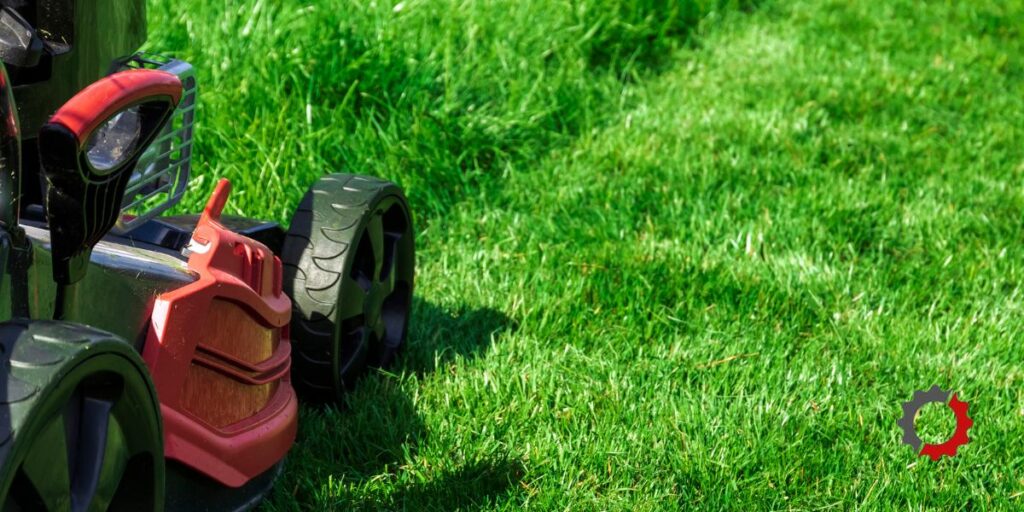You take pride in your lawn and do your best to keep it looking its best. When your lawn mower no longer gives you a nice cut, you need to look into these items:
A lawn mower cuts uneven when a wheel is damaged; the cutting height settings are different; the mower blades are worn or bent; the crankshaft is bent; the mower deck is clogged or damaged; the engine speed is slow, or the ground speed is too fast.
Always take caution working with your mower, especially with the mower deck. Remove the spark plug wire and wear heavy gloves to protect your hands. Follow all safety precautions found in the mower’s operators manual.

This post may include affiliate links. Purchases made through these links may provide a commission for us, at no extra cost to you. As an Amazon Associate, we earn from qualifying purchases.
Follow all safety instructions provided in your equipment operator’s manual prior to diagnosing, repairing, or operating.Consult a professional if you don’t have the skills, or knowledge or are not in the condition to perform the repair safely.
9 Reasons Your Lawn Mower Cuts Unevenly
Damaged Wheel or Incorrect Wheel Settings on Your Lawn Mower
When a wheel becomes loose or damaged, your mower can wobble causing it to cut unevenly. Check the wheels to ensure they are secure and not damaged.
SOLUTION: Tighten any loose hardware and replace a damaged wheel with a wheel of the same size.
Cutting Height Adjustment Set at Different Heights on Your Lawn Mower
Most lawn mowers have several different cutting heights available. When the settings are not the same on both sides of the mower, one side will sit lower than the other. The mower deck will sit unleveled causing the mower to have a taller cut on one side.
SOLUTION: Check the height adjustment on the mower to ensure they are the same on both the left and right-hand sides.
Bent Lawn Mower Blade
A lawn mower can become bent when it impacts a hard object like a stump or rock. A blade that won’t sit level and parallel to the ground will cut the lawn unevenly.
While inspecting the blade, look at the hardware securing the blade to the mower. A loose blade can wobble and affect the cut.
SOLUTION: Remove the spark plug wire and inspect the blade. The best way to check for a bent blade is to actually remove it and place it on top of a new blade. If there are any gaps and noticeable bends, replace the blade.
NEVER attempt to straighten a bent blade. Doing so will compromise the metal. It can weaken the metal and result in a piece of metal breaking off the blade and flying out of the mower.
Worn or Dull Lawn Mower Blade
Mower blades are a wear item. The sand and debris drawn into the mower deck will naturally wear the blade causing a bad and uneven cut.
There are two areas of wearing on the blade that can affect the cut, the sail, and the blade edge. The sail of the blade (the high sides of the blade) helps create air movement under the deck to stand the grass tall.
The blade passes to give it a nice precise cut. The mower blade should be replaced when the metal on the sail shows signs of significant wear.
The other area to look at on the mower blade is the blade edge. A dull mower blade edge will tear the grass and not leave a precise cut. It ends up tearing and beating up the grass blades instead of cutting it.
This may also be the reason your lawn turns brown a day or two after cutting it.
SOLUTION: Replace a mower blade that is extremely worn or has gouges in the cutting edge. If the blade is in good condition, remove the blade from the mower, sharpen it, balance it and reinstall it.
Mower blades should be sharpened after every 25 hours of use and more frequently when you are mowing in sandy conditions. Check out this article for more information on maintaining and sharpening your mower blades.
Bent Push Mower Crankshaft
A bent crankshaft will definitely cause your mower to cut unevenly. You can perform the following tests to determine whether the crankshaft is bent. Be careful and protect your hands from the sharp blade.
With your spark plug removed and a clamp holding the safety lever to the handle to disable the flywheel brake, carefully spin the blade and watch the center bolt. If the bolt is moving all over the place, your crankshaft is most likely bent.
If you are unsure about rotating the blade, remove the blade and blade adapter. Turn the crankshaft and measure to make sure the shaft is remaining in the center.
You can use a dial indicator or some form of a stationary object to gauge whether the crankshaft is moving off-center indicating it is bent.
If it does not remain centered and shifts to one side, the crankshaft is bent and it’s time to replace your lawn mower.
SOLUTION: It’s time to replace a lawn mower with a bent crankshaft. Replacing the crankshaft is more expensive than purchasing a new mower.
Some choose to try to bend the crankshaft back in place, but this poses a significant safety risk. I highly recommend purchasing a new lawn mower.
Clogged Lawn Mower Deck
The area under the mower deck needs to be free of grass buildup. The air movement created by the mower blades under the mower deck allows your mower to create suction.
This suction stands your grass tall so the blade can come by and precisely cut your grass. When the deck is packed with debris, the area available to create this air movement and suction is restricted giving you an uneven cut.
SOLUTION: Keep your mower deck clean by periodically scraping the deck. To minimize grass buildup, avoid mowing wet grass. Not only does wet grass clump in the yard, but it also sticks to your mower deck.
Lawn Mower Engine Speed is Too Slow
The mower deck requires engine power to run at its best. Make sure the throttle position on your mower is placed in the high position.
When your mower deck doesn’t receive the power it needs, the blade speed slows down which can leave you with an uneven cut.
SOLUTION: If you notice your engine is no longer giving you the power it once did, you should bring your mower to an experienced small engine mechanic to have the engine checked out.
Read my article for other items that can make your mower experience a loss of power.
Lawn Mower Ground Speed is Too Fast
Pushing your mower across your lawn at too fast a pace can give you a bad cut. Adjust your speed to your conditions.
Mowing thick, wet or tall grass puts extra strain on your engine. Slow down your speed when mowing in these conditions.
Mowing at too fast of speeds can also cause your mower to push over grass and not accurately cut grass. The bad cut can get worse when the mower is bouncing around on the uneven ground.
SOLUTION: Operate your mower at speeds that match the mowing conditions.
Damaged Lawn Mower Deck
As mentioned prior, the mower deck is designed to maximize the airflow created by the blade movement. When the deck becomes damaged it no longer performs as designed.
SOLUTION: Attempt to repair a damaged deck so it has its original shape and doesn’t have any holes or punctures.
Still Having Problems with Your Lawn Mower?
Lawn mower ownership doesn’t come without its frustrations. Own a lawn mower long enough, you are bound to run into many lawn mower problems including starting, smoking, leaking, cutting, and overheating.
For a list of the most common lawn mower problems and items that can cause them, check out my guide “Common Lawn Mower Problems: Solved!“
